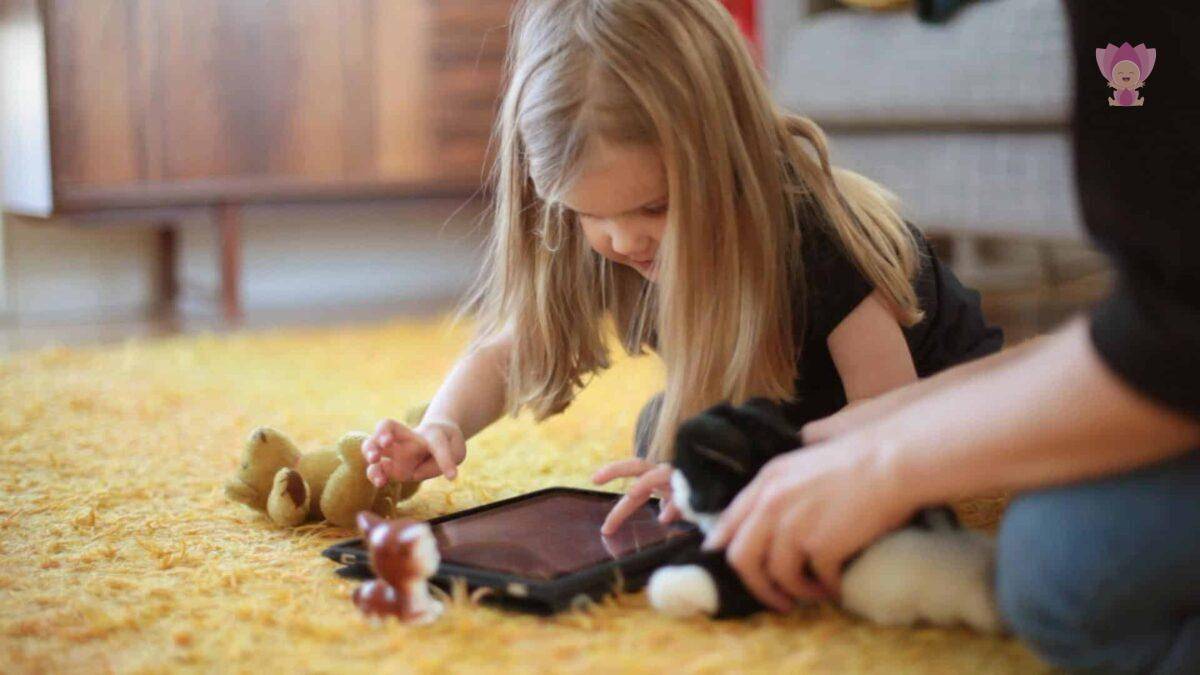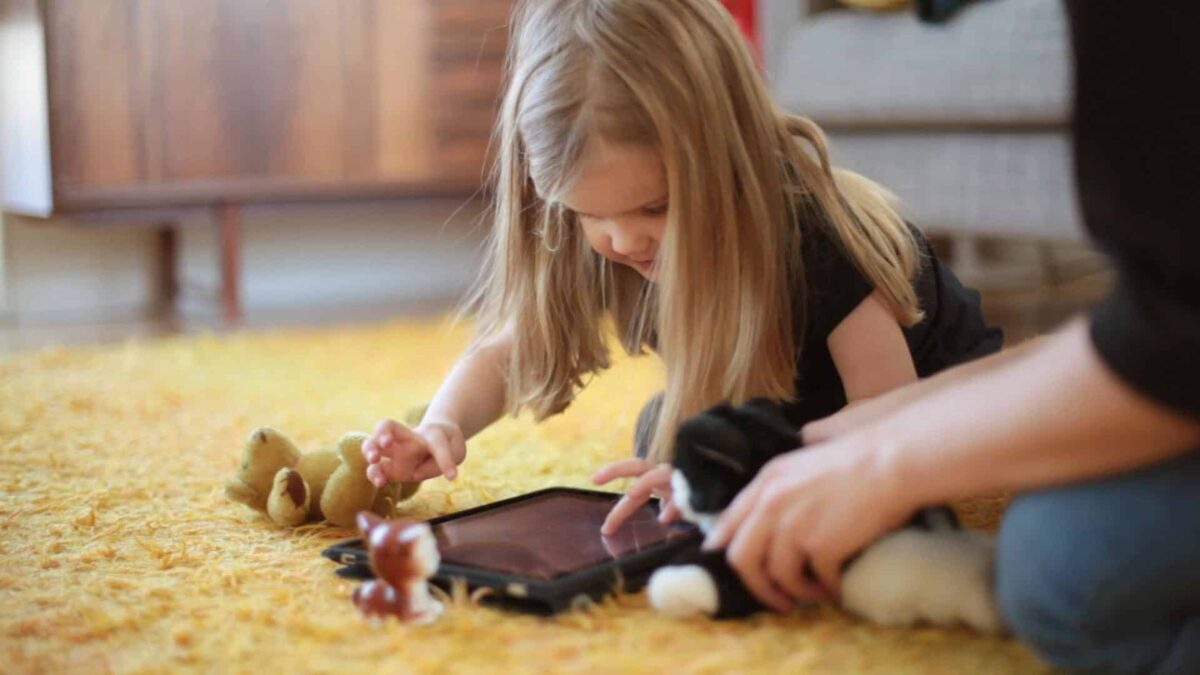How does digital media shape young children’s word learning?

This post is part of our series on Digital Media and Children Under 3, published with collaboration from the journal, Infant Behavior and Development. The featured research appeared in a special issue that focused on how young children engage with technology and ways that parents can facilitate media engagement to promote positive development.
Key takeaways for caregivers
- Many parents look for clear guidance on how to navigate their children’s use of digital media, asking “Is too much screen time bad for my child?” or “How much tablet time should my child get?” But the answer is not a simple “yes” or “less,” especially for infants, toddlers, and preschoolers.
- Instead of hard rules about how much digital media children should use or when, it can be more fruitful to consider how they are using technology, what they are doing with it, and who is engaging with them as they use this media. This is particularly important when looking at impacts on young children’s vocabulary development.
- The world in which young children are growing up is digital. Instead of banning technology, parents should consider how it can supplement their children’s learning instead of distracting from it.
Children’s use of technology and digital media are inevitable: Focus on how and what they are doing with it
Imagine your own childhood and where you learned about new animals – a dog, fish, or even a giraffe or elephant. Chances are, it was by seeing the dog in the neighbor’s yard or watching an elephant at the zoo, perhaps supplemented with stuffed animals or pictures in a storybook.
How children experience the world vs adults
Now consider where your child has encountered the concept of “dog” or “elephant.” In addition to the petting zoo, you might have added “in Paw Patrol” or “while playing ABCMouse” or even (for older children) “in Minecraft.” How children experience the world today is different from how their parents might have, or even from how an older sibling might have learned before the COVID-19 pandemic began.
Technology and digital media are rapidly increasing and present in daily life for most Western families. They are impossible to avoid for adults and young children alike. Most parents have wondered if too much screen time will cause their child to be delayed or if particular applications can “fry children’s brains.” They wonder if it is okay to let their child use a tablet every so often, or which applications are educational. The truth is that there is not an easy response to these questions because the answer varies depending on the family, child, and type of media being consumed.

Photo: Toca Boca. Creative Commons.
Advice on how to navigate this space as a parent or caregiver is also changing rapidly, in part because research is still yielding results. Each day, researchers add a bit more to our knowledge of how children use technology, what it means for their learning, and what later impacts it might have. As we continue to learn more about the role of technology and digital media in young children’s lives, updating how we think about technology and looking to the future can be instructive.
In a recent paper, I examined the role of digital media by considering whether questions about what and how much children are using are not the right questions to ask in the first place. Instead, what if we asked: How are children using technology? What is their experience with digital media like? Who is helping or interacting with young children as they engage in screen time at home?
Questions might also consider how digital context differs from real-world experiences, how the content of digital applications varies from the content in books or toys, and how each child and household may be unique in their uses of and needs for technology.
Learning in a digital context differs from learning with real items
Digital applications are often less social than real-world interactions, with fewer interactive elements. Even when an application or program includes a relatable human character, it often does not factor in the child’s responses or behavior or has low quality of an interaction (e.g., it asks hypothetical questions, but does not allow time for the child to respond).
Most parents have wondered if too much screen time will cause their child to be delayed, or if particular applications can “fry children’s brains.”
We know that having dyadic – real-time, back-and-forth – conversations is critical for children’s language development. The more digital videos replace everyday conversations like grocery store banter or before-bedtime rituals, the fewer words and language skills children learn. Nonetheless, when technology is used in ways that make the context social – such as connecting with Grandma on video chat or playing a joint game in an application – children’s learning and social connectedness improve.
Digital learning allows less exploration
In addition to digital contexts being less social than actual conversations, they are also less rich and allow less exploration. Cartoons and 2D drawings are frequent in digital media and many features of the real world simply cannot be replicated even in virtual reality (e.g., the technology for virtual smells and tastes is still in development and uncommon outside of high-tech centers). This means that digital context at home is simpler and of lower quality than what real life might provide a child.
But that does not mean children cannot learn from digital media. Rather, it means that they are more likely to do when experiences that cannot be replicated online (e.g., smells, tastes, 3D forms) are supplemented off screen. For instance, if a child is learning the word “milk” on an application, she can see the shape of the milk carton, notice its white color, and discover that it is a drink.
Yet if the concept of milk is only presented in simple images on a screen, richer details about actual milk cannot be captured (e.g., texture, material). For example, on a screen, spilled milk might look the same as spilled glue. Only as children explore in real-world settings, such as at mealtimes, can they gain critical knowledge through touch, such as realizing the watery texture of milk and preventing a glue-eating mishap.

Photo: Alex Green. Pexels.
Digital content differs from real-world experiences
The recorded dialogue that makes up most digital media is often slower and more formal than what children hear at home. Similarly, objects in a picture are seen from only one angle without the opportunity to rotate, touch, or attempt to eat the item. These limited views are harder to learn from in the moment. They also make it harder for children to transfer learning from the tablet to the real world; in a phenomenon called the transfer deficit, children may learn the name of a new toy in a video but not be able to recognize the same toy in real life.
However, if children get a real-world foundation first, it can be easier for them to recognize and learn more about those items when they appear in a digital form. Moreover, digital worlds make it possible for children to get a wider variety of experiences – seeing fairy tales in action, or new examples of exotic animals that go beyond the static storybook. This sort of variety is beneficial, especially when learning new words. So digital content is not inherently bad, but supplementing it with real world experiences is key.
Digital media learning needs to be adapted to each individual child
How children interact with digital media varies based on their age, which can change what children do with it, which in turn influences how technology may affect their learning. For instance, by age three, most children know the names of more than 300 different real-life objects and are starting to extend these labels to new items, including those in digital form. But they may have trouble transferring learning the reverse way – from a tablet to the world. Similarly, by the time most children are four, their cognitive maturity is advanced and the transfer deficit presents less of a barrier to learning.
In essence, as children get older and engage in more rich, social experiences, they learn how to learn. Once they know how to learn, they can extend that new ability to new places, including technology.
When technology is used in ways that make the context social – such as connecting with Grandma on video chat or playing a joint game in an application – children’s learning and social connectedness improve.
At the same time, every child is different, with unique strengths and backgrounds. Some children with vision or hearing deficits may need a tablet for adaptive purposes. Other children may be extremely shy but can slowly gain confidence in communicating by using FaceTime.
There are also vast differences in how different cultures and families of different socioeconomic statuses use technology, with children’s prior experience with technology varying as widely as the ways in which it is used. For these reasons, it is difficult if not impossible to give blanket advice on whether children should or should not use technology, or how much screen time they should have.
Focus on how and what children are learning in both digital and real-world experiences
Children’s future includes technology. And that technology looks different from what parents and caregivers have experienced, and will differ even more a few years from now. As the digital landscape shifts, parents should look for digital experiences that are interactive, driven by children’s curiosity, and variable, and that can be supplemented with real-life experiences and social interactions.
But parents and caregivers also should not be too concerned. If children are getting rich real-world interactions and their exposure to technology is supplemented with a variety of other experiences, they will have opportunities for deep learning. Instead of wondering if there should be more or less screen time, parents should think about how and what their children are learning and lean into the children’s world to engage with them.
















Leave a comment